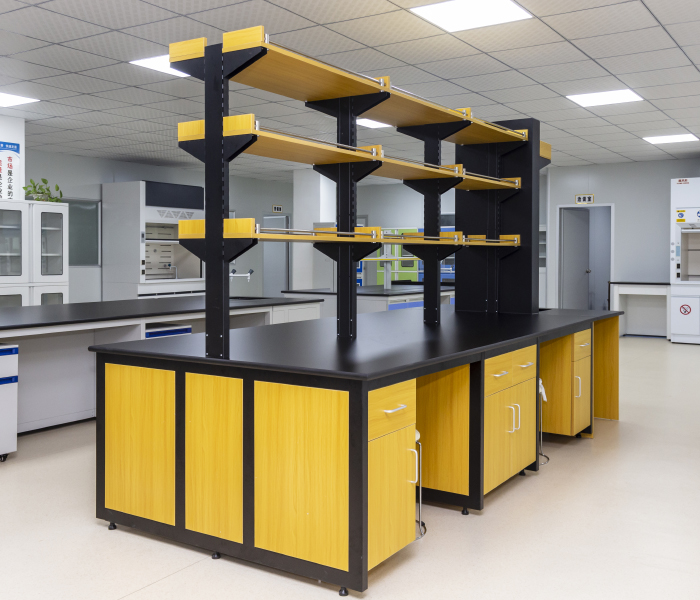Table of Contents
Laboratory islands have become an essential feature in modern labs, offering versatility, efficiency, and functionality. Whether you’re designing a new lab or upgrading an existing one, investing in the right laboratory island table can transform the way you work. As an expert in lab furniture, this comprehensive guide will help you navigate the various benefits, types, features, and options available to ensure you find the perfect lab island tailored to your needs.
Benefits of Using a Laboratory Island in Modern Labs
Laboratory islands are a crucial piece of furniture for maximizing space and improving lab workflows. Here’s why they are a valuable addition to any modern lab:
- Space Optimization: Laboratory islands are centrally placed, which allows lab technicians to access the workspace from all sides. This design makes them ideal for group work, experiments requiring multiple tools, or when multiple researchers need to collaborate simultaneously.
- Accessibility from All Sides: The open design of a lab island makes equipment and materials easy to reach from any angle, promoting efficiency and reducing the need for excessive movement. It creates a more flexible and user-friendly workspace, especially in fast-paced environments.
- Multipurpose Use: Whether it’s for conducting experiments, analyzing samples, or simply as a prep area, laboratory islands are highly versatile. They can be configured with integrated utilities (gas, water, power) and additional storage to suit the specific needs of any lab.
Different Types of Laboratory Island Tables for Specialized Labs
Laboratory islands are not a one-size-fits-all solution. Different types of labs have unique requirements, and choosing the right type of laboratory island is crucial for optimal performance:
- Chemistry Labs: In chemistry labs, islands must prioritize chemical resistance and safety. Surfaces like epoxy resin or phenolic resin are essential for handling harsh chemicals. Integrated sinks, fume hoods, and gas utilities are common additions for chemistry lab islands.
- Biological Research Labs: For biological research labs, laboratory islands often focus on cleanability and hygiene. Stainless steel surfaces, which are easy to disinfect and maintain, are ideal. Additionally, islands in biology labs may include integrated biosafety features.
- Industrial Labs: Industrial labs often require heavy-duty islands that can support large equipment and high-volume work. Durability and load-bearing capabilities are key factors, with islands made of reinforced materials like stainless steel or polypropylene.
Key Features to Look for in a Laboratory Island Table
Selecting the right laboratory island table means paying close attention to its core features, which can greatly impact performance and durability:
- Durable Materials: Depending on the type of lab, you’ll need materials that can withstand wear and tear, spills, and harsh substances. Common materials include stainless steel, phenolic resin, and polypropylene.
- Chemical Resistance: Especially important in chemistry and industrial labs, the island’s surface must be able to resist corrosion from chemicals without degrading over time.
- Integrated Storage: Laboratory islands often come with built-in drawers or cabinets for easy access to equipment and supplies. Customizable storage options can be tailored to specific needs.
- Customizable Configurations: Many lab islands can be tailored with modular components, allowing you to reconfigure the layout as your lab’s needs evolve.
Customizing Laboratory Island Tables for Your Specific Needs
Every lab has unique requirements, and laboratory islands can be customized to meet those specific needs. Here are some key areas where customization can make a big difference:
- Size: Lab islands come in various sizes, allowing you to choose one that fits your available space without compromising the flow of movement or access to equipment.
- Storage: Depending on your workflow, your lab island can include a mix of drawers, cabinets, and open shelving. Custom configurations are available to match your storage requirements.
- Utilities: Islands can be outfitted with integrated gas lines, water taps, and electrical outlets, providing a complete workspace with everything needed at your fingertips.
- Surface Materials: Whether you need chemical resistance, heat tolerance, or easy cleaning, surface materials can be selected to match the demands of your lab work.
Cost-Effective Laboratory Island Solutions for Budget-Conscious Labs
Setting up a lab can be costly, but you don’t need to sacrifice quality for affordability. There are budget-friendly options that still deliver durable and efficient solutions:
- Modular Islands: Opting for modular lab islands allows you to start with a basic setup and expand as your budget allows. This is particularly useful for growing labs or those anticipating future needs.
- Durable Yet Affordable Materials: Phenolic resin and epoxy resin offer high performance at a lower cost compared to stainless steel, making them excellent choices for budget-conscious labs.
- Pre-Configured Options: Many manufacturers offer pre-designed lab islands that come at a lower cost than fully customized models, making them an attractive choice for labs on a tight budget.
Safety Considerations When Installing a Laboratory Island
Safety is a top priority in any lab environment. When installing a laboratory island, here are the key factors to consider:
- Ventilation: Ensure that the island is positioned in a well-ventilated area, especially if working with chemicals. Some islands may also be equipped with built-in fume hoods for additional safety.
- Electrical Wiring: If your lab island includes electrical outlets, ensure that the wiring is properly installed and meets safety standards to prevent hazards like electrical shock or fire.
- Accessibility to Emergency Equipment: Lab islands should not obstruct access to emergency equipment such as fire extinguishers, eyewash stations, or safety showers.
Maintenance and Longevity of Laboratory Island Tables
A well-maintained laboratory island can last for many years, providing reliable service and value. Here are some tips to keep your lab island in top condition:
- Regular Cleaning: Keep the surface free of debris, spills, and contaminants by regularly cleaning it with appropriate solutions based on the material (e.g., disinfectants for stainless steel or mild cleaners for epoxy resin).
- Preventive Care: Regularly check for signs of wear and tear on the island’s surface, joints, and fixtures. Address minor issues promptly to prevent more serious damage.
- Surface Protection: For islands exposed to harsh chemicals, consider using protective mats or trays to prevent direct contact and reduce the risk of surface degradation.




